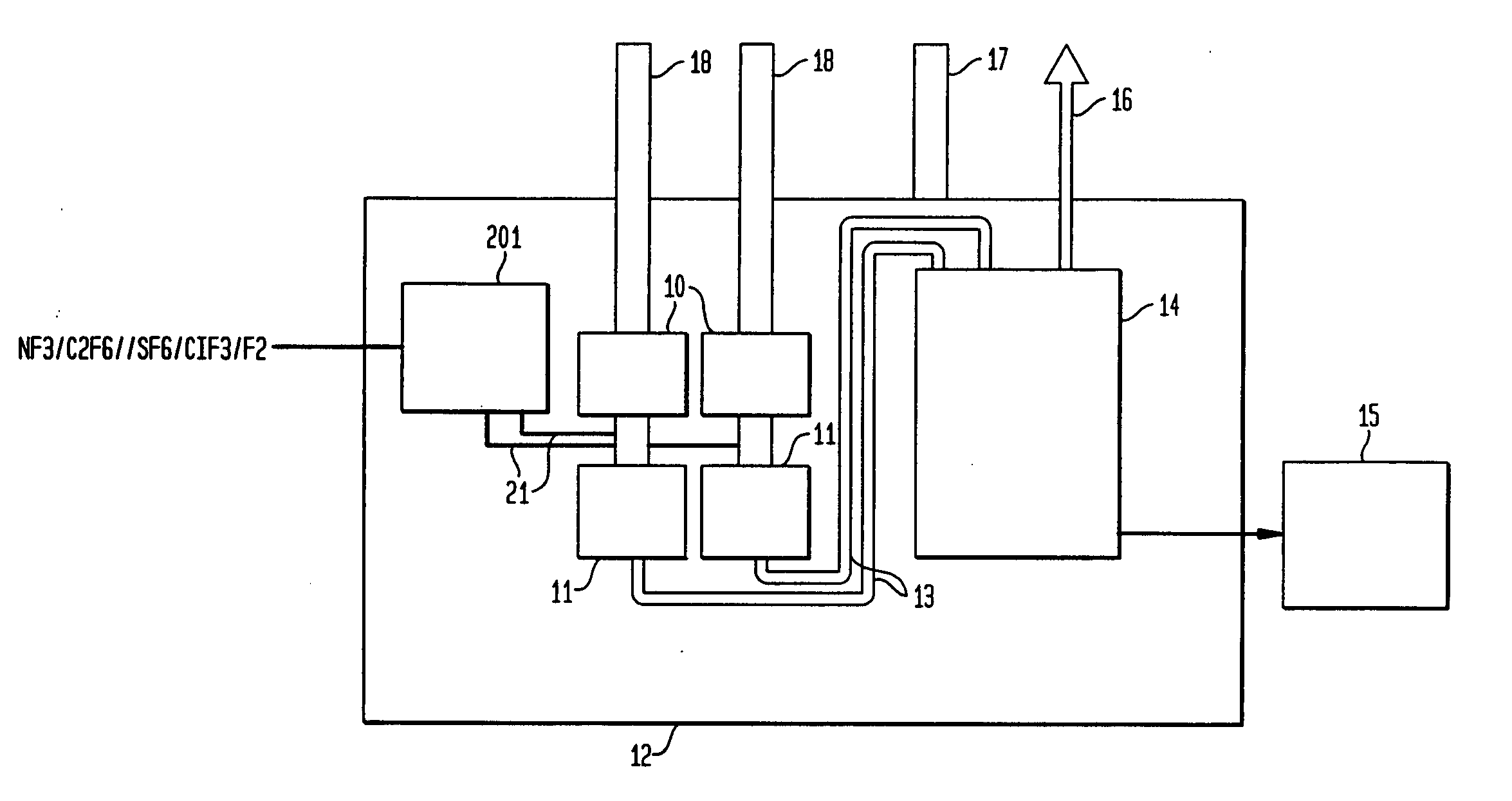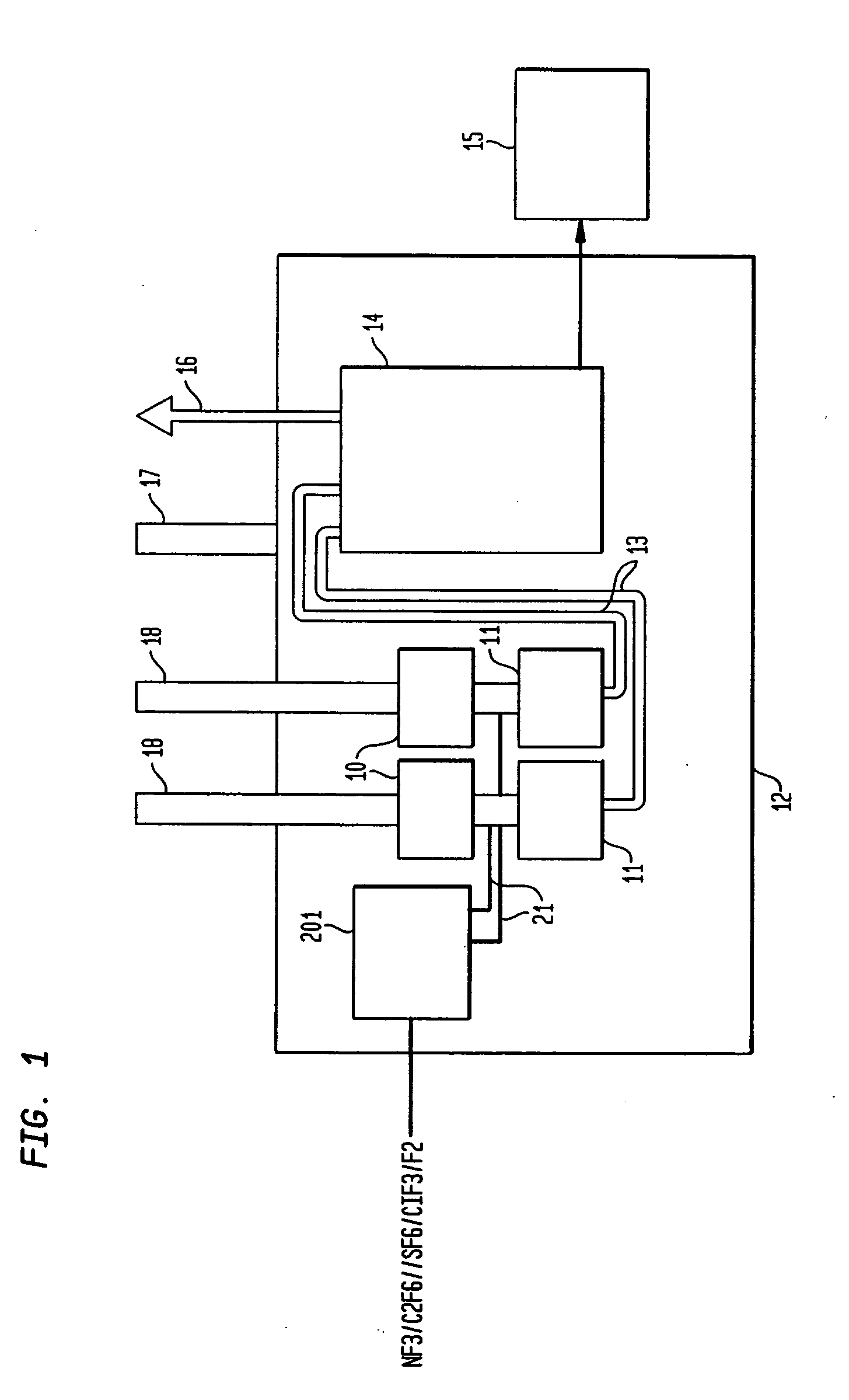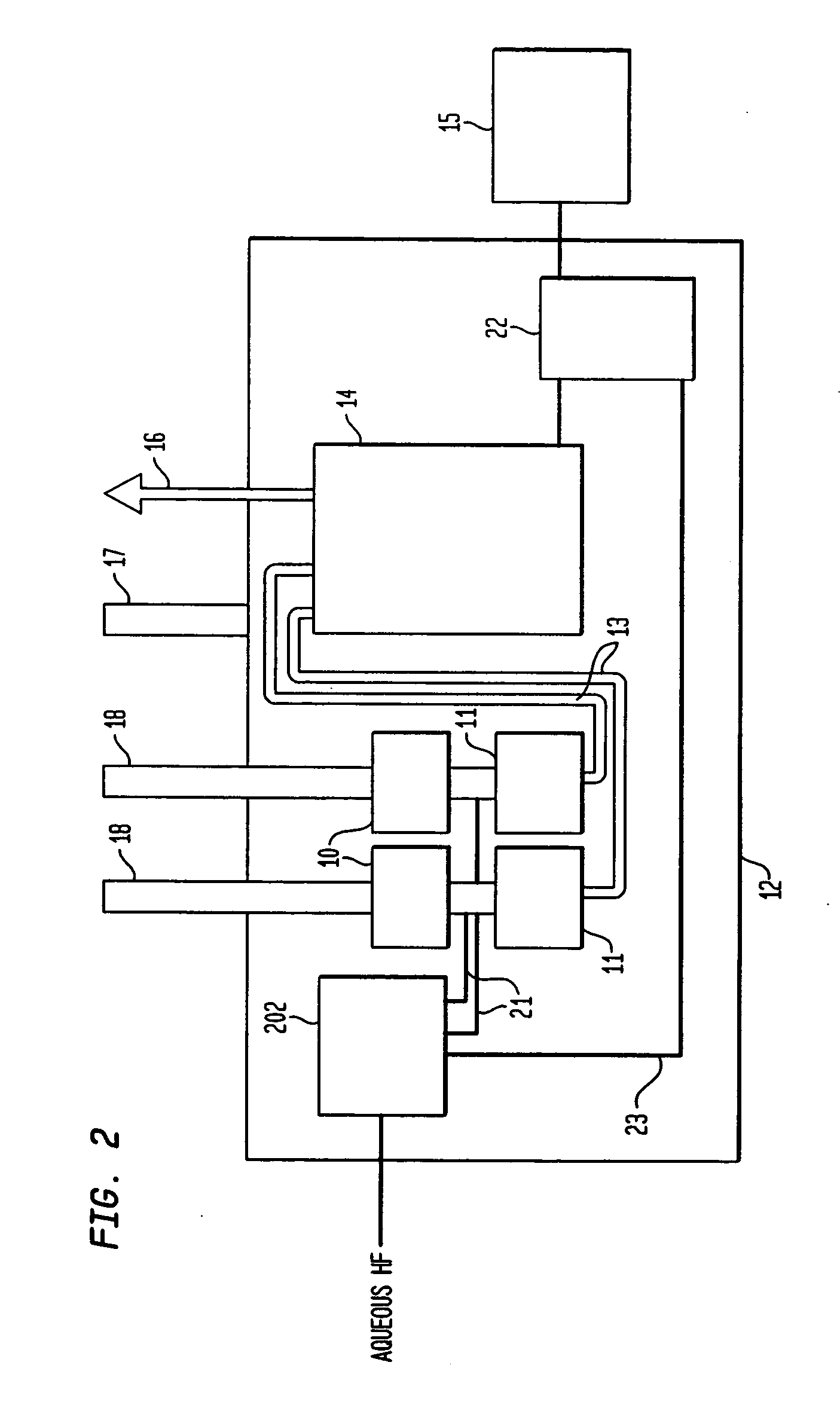Method and apparatus for maintaining by-product volatility in deposition process
a technology of by-products and deposition processes, which is applied in the direction of perfluorocarbon/hydrofluorocarbon capture, sustainable manufacturing/processing, and final product manufacturing, etc., can solve the problems of cvd process drawbacks, delay in production and thus cost, and reduce so as to improve the efficiency of the deposition system, reduce or substantially eliminate the amount of by-products produced
Inactive Publication Date: 2005-11-10
EDWARDS VACUUM INC
View PDF23 Cites 50 Cited by
- Summary
- Abstract
- Description
- Claims
- Application Information
AI Technical Summary
Benefits of technology
[0009] The present invention is directed to a method, system and apparatus for improving the efficiency of a deposition system by decreasing or substantially eliminating the amount of by-products produced during the deposition system by providing an atmosphere to predictably maintain the volatility of produced by-products to prevent unwanted volumes of by-product deposition on the system pump, inner surfaces of the lines and chambers, and on other component surfaces.
[0010] Further, the present invention is directed to a method, system and apparatus for improving the efficiency of a deposition system by decreasing or substantially eliminating the amount of by-products produced during the deposition system by providing an atmosphere to predictably re-volatize any deposited by-products that have been deposited on pump and component surfaces.
[0011] More specifically, the present invention is directed to a method, system and apparatus for improving the efficiency of a deposition system by decreasing or substantially eliminating the amount of by-products produced during the deposition system by providing a fluorine atmosphere in the deposition process, the atmosphere comprising molecular fluorine (F2) or fluorine in the radical form (F*), and the fluorine atmosphere introduced to the apparatus in the foreline.
Problems solved by technology
Such ALD processes produce by-products that adhere to and otherwise cause deleterious processing effects in the deposition apparatus components.
Such effects include pump seizure, pump failure, impure deposition, impurities adhering to reaction chamber walls, etc. that requires the deposition process to be suspended while the by-products are removed, or the fouled components are replaced.
The suspension of the production is timely and thus costly.
Such drawbacks also occur in Chemical Vapor Deposition (CVD) processes.
However, such problems often occur with greater frequency during ALD since, in ALD processes, the gases fed into the reaction chamber and the intended reaction is a surface reaction on the substrate being treated (e.g., IC devices).
As a result, a significant volume of the unreacted gases is available to react outside the reaction chamber in locations such as in the process foreline and the pumps.
It is believed that this condition in ALD processes results in higher unwanted non-chamber deposition rates, which leads to pump and foreline “clogging” and resulting in pump failure with respect to both seizure and restart.
Various solutions have been attempted, but are time-consuming, costly, or otherwise impractical for various reasons including space allocation.
As a result, this solution is not desirable due to increased processing cost.
In addition, this solution is incomplete as portions of the reactant gases may still combine and react before they reach the chamber's exit valve.
However, the significant amount of by-product exiting the reaction chamber and the expected proportion of reactivity of the species make this approach unworkable for ALD systems.
Method used
the structure of the environmentally friendly knitted fabric provided by the present invention; figure 2 Flow chart of the yarn wrapping machine for environmentally friendly knitted fabrics and storage devices; image 3 Is the parameter map of the yarn covering machine
View moreImage
Smart Image Click on the blue labels to locate them in the text.
Smart ImageViewing Examples
Examples
Experimental program
Comparison scheme
Effect test
examples
[0037] Test results confirming the viability of the solutions offered by the present invention were obtained, and are shown in Table 1 below.
TABLE 1F2NF3ArTempPressureRun #slmslmslmC.PlasmaEtchTimetorr01130yesfastmin2.310.5550nonone101.971a1150yesfast6221170nonone101331170nonone622.940.5530yesslow4350.5530yesslow3.760.5230yesslow3.371.51.530yesslow307a1.771.730yesfast5.6
the structure of the environmentally friendly knitted fabric provided by the present invention; figure 2 Flow chart of the yarn wrapping machine for environmentally friendly knitted fabrics and storage devices; image 3 Is the parameter map of the yarn covering machine
Login to View More PUM
| Property | Measurement | Unit |
|---|---|---|
| pressures | aaaaa | aaaaa |
| thickness | aaaaa | aaaaa |
| temperature | aaaaa | aaaaa |
Login to View More
Abstract
A method and apparatus for introducing a fluorine-containing flow stream to a deposition process to maintain process by-product volatility and reduce or eliminate by-product formation and / or interference.
Description
BACKGROUND OF THE INVENTION [0001] Thin film deposition processes for depositing films of pure and compound materials are known. In recent years, the dominant technique for thin film deposition has been chemical vapor deposition (CVD). A variant of CVD, Atomic Layer Deposition (ALD) has been considered to be an improvement in thin layer deposition in terms of uniformity and conformity, especially for low temperature deposition. ALD was originally termed Atomic Layer Epitaxy, for which a competent reference is Atomic Layer Epitaxy, edited by T. Sunola and M. Simpson (Blackie, Glasgo and London, 1990). [0002] Generally, ALD is process wherein conventional CVD processes are divided into single-monolayer deposition steps, wherein each separate deposition step theoretically goes to saturation at a single molecular or atomic monolayer thickness, and self-terminates. The deposition is the outcome of chemical reactions between reactive molecular precursors and the substrate. In similarity t...
Claims
the structure of the environmentally friendly knitted fabric provided by the present invention; figure 2 Flow chart of the yarn wrapping machine for environmentally friendly knitted fabrics and storage devices; image 3 Is the parameter map of the yarn covering machine
Login to View More Application Information
Patent Timeline
 Login to View More
Login to View More Patent Type & Authority Applications(United States)
IPC IPC(8): C23C16/452C23C16/44C23C16/455H01J37/32H01L21/285H01L21/3065
CPCC23C16/4405C23C16/4412Y02C20/30H01J37/32844H01J37/3244Y02P70/50C23C16/455
Inventor BAILEY, CHRISTOPHER M.HOGLE, RICHARDPURDON, SIMON JAMESPRADHAN-KASMALKAR, REVATISULLIVAN, AARON DAVERWANG, QING MINMA, CE
Owner EDWARDS VACUUM INC
Features
- R&D
- Intellectual Property
- Life Sciences
- Materials
- Tech Scout
Why Patsnap Eureka
- Unparalleled Data Quality
- Higher Quality Content
- 60% Fewer Hallucinations
Social media
Patsnap Eureka Blog
Learn More Browse by: Latest US Patents, China's latest patents, Technical Efficacy Thesaurus, Application Domain, Technology Topic, Popular Technical Reports.
© 2025 PatSnap. All rights reserved.Legal|Privacy policy|Modern Slavery Act Transparency Statement|Sitemap|About US| Contact US: help@patsnap.com



